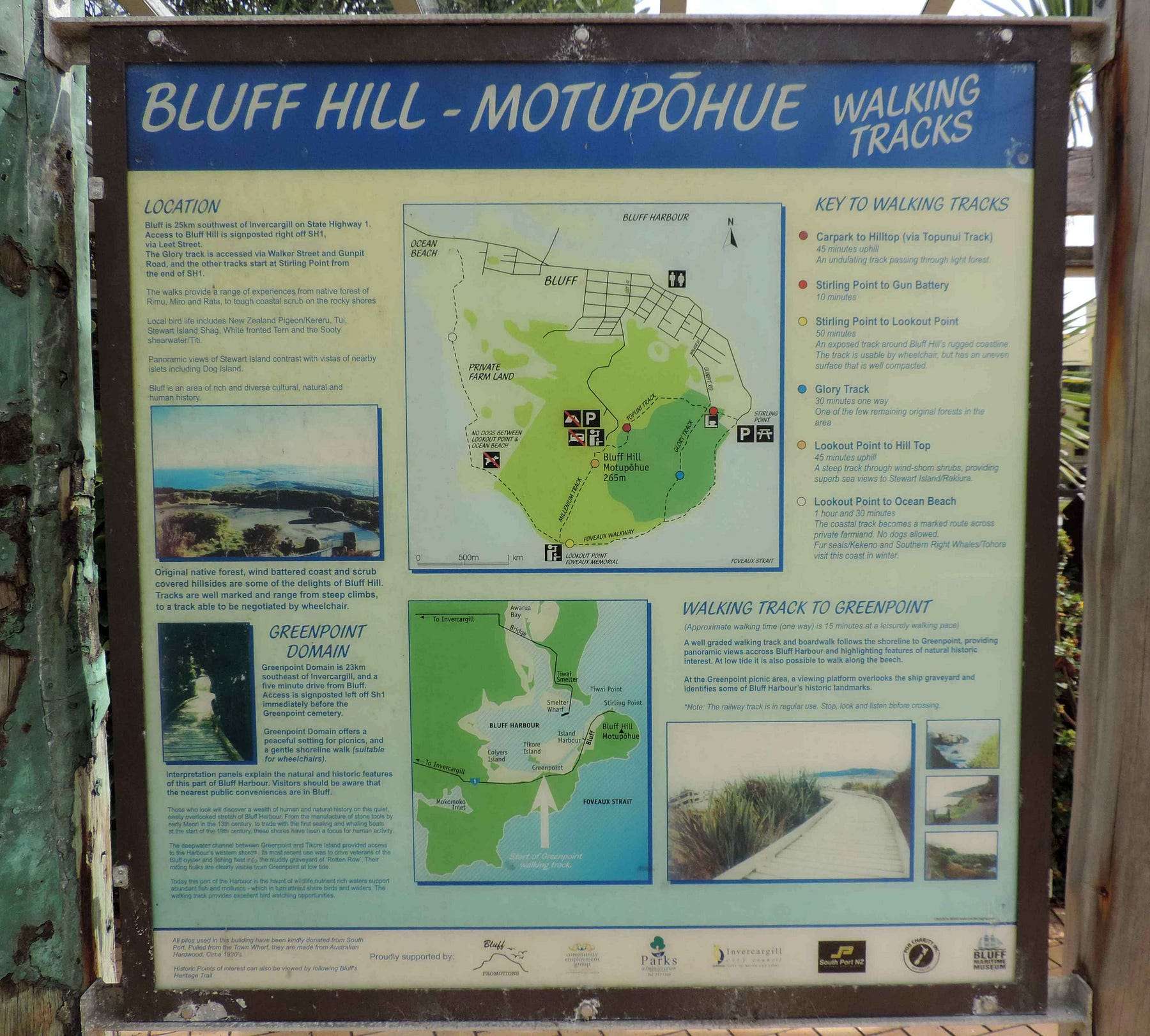
AFTER Invercargill, I like to visit its port of Bluff, which is even further south; indeed the second-southernmost predominantly English-speaking town after the similarly sized Stanley on the Falklands (or Malvinas).
Though isolated and remote even by New Zealand standards, and completely at the wrong end of the country as far as the rest of the world is concerned, Bluff is, nevertheless, an important port.
Part of the reason for this is that Bluff serves the Tiwai Point aluminium smelter, a plant that uses hydroelectric power from the Manapōuri power station to smelt what is said to be the world’s purest aluminium.
Here’s a view from the top of Bluff Hill, a high point that shelters Bluff from some of the worst of the winds in these latitudes and also gives it its name. You can see a sliver of the town toward the left and, just above it, a ship tied to the other side of the harbour (Tiwai Point) by way of a long conveyer that carries aluminium ore to the smelter, and aluminium ingots out. Toward the right, you can also see the magnificent beach of Toetoes Bay.

The Tiwai Point smelter was commissioned in 1971. In those days, I think, the politicians had a vision of New Zealand as the Sweden or Switzerland of the South Pacific, making expensive added-value products such as racing bike components out of the aluminium.
But these days, 90% of it is exported as ingots.
When Tiwai Point was being prepared for the smelter, it was extensively excavated by archaeologists, who retrieved many tonnes of Māori artifacts. It turned out that Tiwai Point had been used to make stone tools on an industrial scale, well before the coming of modern industry.
Bluff is also famous for its Bluff oysters, which come into season from the first of March onward.

Bluff is the oldest settler town in New Zealand: two hundred years old last year!

As a result, there is a heritage trail, and heritage walks.

My friend Chris also came across a list of things to do, on a recent trip with my father. This included heading up Bluff Hill to its hiking trails and spectacular viewing platform.

The Māori name for Bluff Hill is Motupōhue, meaning ‘isle of vines.’ Motupōhue isn’t quite an island, as you can see.



Bluff is really gritty and industrial, a genuine working port. It’s really more of a pub town than a cafe town, and signs of gentrification are rare.


On the other hand, it has been done up a bit with paint and murals along the waterfront, as we can see from the following photos.






There’s a link to the walks on Bluff Hill here, also shown on a more detailed billboard that Chris also came across.

When I was in Bluff a few years ago, the January weather had turned into the opposite of summer, as it often does in these parts, which lie in the latitude of Patagonia and face south toward Antarctica.
The attractions of Bluff are a bit like Britain’s famous ‘Skegness is so bracing’ tourist poster, which makes the best of a place that can’t exactly claim to be the Riviera. And so it is for Bluff and Southland in general, even though this part of the country has stunning beaches that would attract millions if only they were in a balmier location.

The weather was a bit better on another occasion, however. I wouldn’t want to give the impression that it is always terrible!

The views from the top of Bluff Hill are fantastic. Here are a couple more, first of all looking westward:

And then another looking southward, toward Rakiura/Stewart Island.

Here is a video panorama from the top.
There were information panels on the wildlife of Bluff Hill, both present and extinct.

Much of it has been lost to imported pest species, including a cat contemplating a little dead bird, and an extra-greedy-looking possum.

There’s an old gun emplacement on the hill, created just in case anyone ever tried to attack the most southerly trading port in the British Empire and work upwards toward London from there (they didn’t).


And a radar station, also similarly derelict these days though there are now modern communications masts that sing in the almost unceasing wind.
Plus, there’s also significant Māori culture on the isle of vines. Although South Island Māori faced a harsher environment and were fewer in number than in the North Island, this area is known for its fat juvenile seabirds, known as tītī or muttonbirds, which would be regularly harvested and preserved and thus helped to sustain human life.
Motupōhue is one of the most significant places to the southern Māori, and has had a symbolic tōpuni, or cloak of honour, placed over it.

Finally, this is me trying to narrate a video about the view down to the town of Bluff and the Tiwai Point aluminium smelter.
But do come to Bluff — it’s so bracing!
There’s more about this part of the country in one of my books, The Sensational South Island, on sale on my website a-maverick.com.


Subscribe to our mailing list to receive free giveaways!